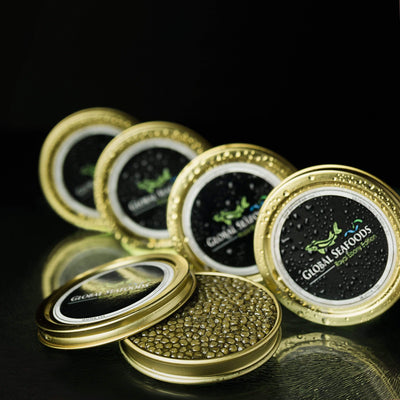Caviar vs. Roe: Key Differences, Uses, and Benefits

Caviar vs. Roe: Understanding the Differences
Caviar and roe are two delicacies often mistaken for one another due to their common origin—fish eggs. However, they differ significantly in terms of taste, texture, price, and culinary applications. In this guide, we’ll dive deep into the world of sturgeon caviar and roe, uncovering their unique characteristics, nutritional benefits, and how to enjoy them to their fullest potential.
What is Sturgeon Caviar?
Definition and Origins
Sturgeon caviar is the epitome of luxury in the culinary world. Harvested from sturgeon species such as Beluga, Osetra, and Sevruga, it is prized for its exquisite flavor and buttery texture. The Caspian and Black Sea regions have long been known as the primary sources of the finest sturgeon caviar, although sustainable aquaculture practices have expanded its availability globally.
Why is Sturgeon Caviar So Expensive?
The rarity and price of sturgeon caviar stem from the long maturation period of sturgeon fish, which can take up to 20 years to produce eggs. Combined with meticulous harvesting techniques and strict regulations, this scarcity has made sturgeon caviar a symbol of luxury and exclusivity.
Flavor and Texture
- Color and Appearance: Light gray to black, with shiny, large eggs.
- Taste: Delicate, creamy, and slightly briny with a buttery finish.
- Texture: Smooth, with a satisfying “pop” that releases its rich flavor.
For premium sturgeon caviar, explore Beluga Caviar and Russian Ossetra Sturgeon Caviar.
What is Roe?
Definition and Varieties
Roe refers to fish eggs from various species, including salmon, trout, and herring. Unlike sturgeon caviar, which comes exclusively from sturgeon, roe is more accessible and affordable, catering to a broader range of culinary preferences.
Popular Types of Roe
- Salmon Roe (Ikura): Large, orange eggs with a sweet, briny flavor.
- Trout Roe: Smaller, milder, and often used as a garnish.
- Herring Roe: Delicate in flavor and softer in texture.
Flavor and Texture
- Color and Appearance: Bright orange to pale yellow, depending on the species.
- Taste: Ranges from mildly sweet to intensely salty.
- Texture: Firm, with a pronounced pop.
Discover diverse roe options like Kaluga Caviar and Siberian Sturgeon Caviar.
Comparing Sturgeon Caviar and Roe
| Feature | Sturgeon Caviar | Roe |
|---|---|---|
| Source | Sturgeon (e.g., Beluga, Osetra) | Various fish (e.g., salmon, trout) |
| Price | High due to rarity and demand | More affordable and widely available |
| Flavor | Delicate, buttery, and refined | Bold, briny, and versatile |
| Texture | Smooth, creamy, with a light pop | Firmer, with a pronounced burst |
| Culinary Use | High-end dishes, gourmet presentations | Everyday meals, sushi, and garnishes |
How to Serve and Enjoy
Serving Sturgeon Caviar
- Temperature: Serve chilled at 28–32°F (-2–0°C).
- Utensils: Use non-metallic spoons, like mother-of-pearl, to preserve the flavor.
- Accompaniments: Pair with blinis, toast points, or unsalted crackers, and add crème fraîche or finely chopped onions.
- Beverage Pairing: Champagne, vodka, or a dry white wine enhances the delicacy’s flavor.
Serving Roe
- Versatility: Use as a sushi topping, salad garnish, or accompaniment for seafood dishes.
- Accompaniments: Pair with avocado, cucumber, or cream cheese for contrasting flavors.
- Beverage Pairing: Light beers or citrusy cocktails work well with roe.
Nutritional Benefits of Caviar and Roe
Both caviar and roe are rich in nutrients, making them as healthy as they are delicious.
Omega-3 Fatty Acids
- Caviar: Supports heart health, reduces inflammation, and boosts brain function.
- Roe: Provides similar benefits, though in varying concentrations depending on the species.
Vitamins and Minerals
- Caviar: High in vitamin B12, selenium, and iron, essential for energy and immunity.
- Roe: Rich in vitamin D and protein, ideal for bone health and muscle repair.
FAQs
Can roe replace caviar in recipes?
Yes, but expect differences in flavor and texture. Roe can be a cost-effective alternative in dishes where luxury isn’t the focus.
Is sturgeon caviar sustainable?
Sustainably farmed sturgeon caviar is available, ensuring ethical production and species preservation.
How long can caviar or roe be stored?
Both should be consumed within 2–3 days of opening and stored in the coldest part of the refrigerator.
Conclusion
While sturgeon caviar is a luxurious delicacy reserved for special occasions, roe offers an affordable and versatile alternative for everyday culinary adventures. Each has its unique appeal, whether you're indulging in the buttery elegance of sturgeon caviar or the vibrant flavors of salmon roe.
Whichever you choose, ensure you’re sourcing from reputable suppliers to enjoy the best quality and taste.
Where to Buy Premium Caviar and Roe
Check out more culinary tips and recipes on our YouTube Channel.
Also in News

How to Make Sea Bream Sushi With Dry-Aged Tuna & Crab Roll — Step-by-Step With Chef Joshua
A complete guide to making Sea Bream sushi at home, including filleting, curing, slicing, and building a Dry-Aged Tuna & Crab sushi roll. Chef Joshua shares professional tips for restaurant-quality results.

Boiled Crab for Game Night: Everything You Need for a Perfect Seafood Party
Take your game night to the next level with a Boiled crab party. Learn the best recipes, cooking tips, and hosting hacks for a memorable seafood feast.

Boiled Crab for Date Night: A Romantic Guide to the Perfect Seafood Feast
Make your next date night unforgettable with a romantic Boiled crab experience. This guide covers everything you need to know, from ambiance to the best crab varieties.

